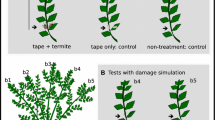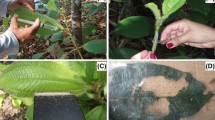Abstract
The aggressive behavior of ants that protect plants from herbivores in exchange for rewards such as shelter or food is thought to be an important form of biotic defense against herbivory, particularly in tropical systems. To date, however, no one has compared the defensive responses of different ant taxa associated with the same plant species, and attempted to relate these differences to longer-term efficacy of ant defense. We used experimental cues associated with herbivory—physical damage and extracts of chemical volatiles from leaf tissue—to compare the aggressive responses of two ant species obligately associated with the Amazonian myrmecophyte Tococa bullifera (Melastomataceae). We also conducted a colony removal experiment to quantify the level of resistance from herbivores provided to plants by each ant species. Our experiments demonstrate that some cues eliciting a strong response from one ant species elicited no response by the other. For cues that do elicit responses, the magnitude of these responses can vary interspecifically. These patterns were consistent with the level of resistance provided from herbivores to plants. The colony removal experiment showed that both ant species defend plants from herbivores: however, herbivory was higher on plants colonized by the less aggressive ant species. Our results add to the growing body of literature indicating defensive ant responses are stimulated by cues associated with herbivory. However, they also suggest the local and regional variation in the composition of potential partner taxa could influence the ecology and evolution of defensive mutualisms in ways that have previously remained unexplored.


Similar content being viewed by others
References
Agrawal AA (1998) Leaf damage and associated cues induced aggressive ant recruitment in a neotropical ant-plant. Ecology 79:2100–2112
Agrawal AA, Dubin-Thaler BJ (1999) Induced responses to herbivory in the Neotropical ant-plant association between Azteca ants and Cecropia trees: response of ants to potential inducing cues. Behav Ecol Soc 45:47–54
Agrawal AA, Rutter MT (1998) Dynamic anti-herbivore defense in ant-plants: the role of induced responses. Oikos 83:227–236
Alonso LE (1998) Spatial and temporal variation in the ant occupants of a facultative ant-plant. Biotropica 30:201–213
Beattie AJ (1985) The evolutionary ecology of ant-plant interactions. Cambridge University Press, Cambridge, UK
Benson WW (1985) Amazon ant-plants. In: Prance GT, Lovejoy TE (eds) Amazonia. Pergamon Press, New York, pp 239–266
Bierregaard RO, Gascon C, Lovejoy TE, Mesquita R (eds) (2002) Lessons from Amazonia: the ecology and conservation of a fragmented forest. Yale University Press, New Haven
Bronstein JL (1998) The contribution of ant-plant protection studies to our understanding of mutualism. Biotropica 30:150–161
Brouat C, McKey D, Bessiere JM, Pascal L, Hossaert-McKey M (2000) Leaf volatile compounds and the distribution of ant patrolling in an ant-plant protection mutualism: preliminary results on Leonardoxa (Fabaceae: Caesalpinioideae) and Petalomyrmex (Formicidae: Formicinae). Acta Oecol-Int J Ecol 21:349–357
Coley PD, Barone JA (1996) Herbivory and plant defenses in tropical forests. Annu Rev Ecol Syst 27:305–335
Conover WJ, Iman RL (1981) Rank transformations as a bridge between parametric and nonparametric statistics. Am Stat 35:124–129
Crewe RM, Collingwood CA, Blum MS (1972) Comparative analysis of alarm pheromones in ant genus Crematogaster. Compar Biochem Phys 43:703–716
Davidson DW, McKey D (1993) Ant-plant symbioses: stalking the Chuyachaqui. Trend Ecol Evol 8:326–332
Do Nascimento RR, et al (1998) Pygidial gland of Azteca nr. bicolor and Azteca chartifex: Morphology and chemical identification of volatile components. J Chem Ecol 24:1629–1637
Dyer LA, Letourneau DK (1999) Relative strengths of top-down and bottom-up forces in a tropical forest community. Oecologia 119:265–274
Fearnside PM, Leal Filho N (2002) Soil and development from Amazonia: lessons from the Biological Dynamics of Forest Fragments Project. In: Bierregaard RO Jr, Gascon C, Lovejoy TE, Mesquita R (eds) Lessons from Amazonia: the ecology and conservation of a fragmented forest. Yale University Press, New Haven, pp 291–312
Fiala B, Maschwitz U (1990) Studies on the South East-Asian ant-plant association Crematogaster borneensis/Macaranga: adaptations of the ant partner. Insectes Soc 37:212–231
Fiala B, Maschwitz U, Pong TY, Helbig AJ (1989) Studies of a South East Asian ant-plant association: protection of Macaranga trees by Crematogaster borneensis. Oecologia 79:463–470
Fiala B, Grunsky H, Maschwitz U, Linsenmair KE (1994) Diversity of ant-plant interactions: protective efficacy in Macaranga species with different degrees of ant association. Oecologia 97:186–192
Fonseca CR, Ganade G (1996) Asymmetries, compartments and null interactions in an Amazonian ant-plant community. J Anim Ecol 65:339–347
Fowler HG (1993) Herbivory and assemblage structure of myrmecophytous understory plants and their associated ants in the central Amazon. Insectes Soc 40:137–145
Fuente MAS de la, Marquis RJ (1999) The role of ant-tended extrafloral nectaries in the protection and benefit of a Neotropical rainforest tree. Oecologia 118:192–202
Gaume L, McKey D (1999) An ant-plant mutualisms and its host specific parasite: activity rhythms, young leaf patrolling, and effects on herbivores of two specialist plant-ants inhabiting the same myrmecophyte. Oikos 84:130–144
Heil M (2002) Ecological costs of induced resistance. Curr Opin Plant Biol 5:345–350
Heil M, Fiala B, Maschwitz U, Linsenmair KE (2001a) On benefits of indirect defence: short- and long-term studies of antiherbivore protection via mutualistic ants. Oecologia 126:395–403
Heil M, Koch T, Hilpert A, Fiala B, Boland W, Linsenmair KE (2001b) Extrafloral nectar production of the ant-associated plant, Macaranga tanarius, is an induced, indirect, defensive response elicited by jasmonic acid. Proc Nat Acad Sci USA 98:1083–1088
Hölldobler B, Wilson EO (1990) The ants. Belknap Press of Harvard University Press, Cambridge, Mass.
Inui Y, Itioka T, Murase K, Yamaoka R, Itino T (2001) Chemical recognition of partner plant species by foundress ant queens in Macaranga-Crematogaster myrmecophytism. J Chem Ecol 27:2029–2040
Itioka T, Nomura M, Inui Y, Itino T, Inoue T (2000) Difference in intensity of ant defense among three species of Macaranga myrmecophytes in a southeast Asian dipterocarp forest. Biotropica 32:318–326
Izzo T, Vasconcelos HL (2002) Cheating the cheater: domatia loss minimizes the effects of ant castration in an Amazonian ant-plant. Oecologia 133:200–205
Janzen DH (1966) Coevolution of mutualisms between ants and acacias in Central America. Evolution 20:249–275
Janzen DH (1967) Interaction of the bulls-horn acacia (Acacia cornigera L.) with an ant inhabitant (Pseudomyrmex ferruginea F. Smith) in eastern Mexico. Univ Kansas Sci Bull 47:315–558
Karban R, Agrawal AA, Mangel M (1997) The benefits of induced defenses against herbivores. Ecology 78:1351–1355
Lapola DM, Bruna EM, Vasconcelos HL (2003) Contrasting responses to induction cues by ants inhabiting Maieta guianensis (Melastomataceae). Biotropica 35:295–300
Laurent P, Hamdani A, Braekman JC, Daloze D, Isbell LA, de Biseau JC, Pasteels JM (2003) New 1-alk(en)yl-1,3,5-trihydroxycyclohexanes from the Dufour gland of the African ant Crematogaster nigriceps. Tetrahedron Lett 44:1383–1386
Longino JT (1989) Geographic variation and community structure in an ant-plant mutualism—Azteca and Cecropia in Costa Rica. Biotropica 21:126–132
Mathsoft (1999) S-Plus 2000. Seattle,USA
McKey D (1984) Interaction of the ant-plant Leonardoxa africana (Caesalpiniaceae) with its obligate inhabitants in a rainforest in Cameroon. Biotropica 16:81–99
Michelangeli FA (2000) A cladistic analysis of the genus Tococa (Melastomataceae) based on morphological data. Syst Bot 25:211–234
Ness JH (2003) Catalpa bignoniodes alters extrafloral nectar production after herbivory and attracts ant bodyguards. Oecologia 134:210–218
Palmer TM, Young TP, Stanton ML, Wenk E (2000) Short-term dynamics of an acacia ant community in Laikipia, Kenya. Oecologia 123:425–435
Rankin-de Mérona JM, Prance GT, Hutchings RW, Silva FM, Rodrigues WA, Uehling ME (1992) Preliminary results of large scale tree inventory of upland rain forest in the central Amazon. Acta Amazonica 22:493–534
Rico-Gray V, Garcia-Franco JG, Palacios-Rios M, Diaz-Castelazo C, Parra-Tabla V, Navarro JA (1998) Geographical and seasonal variation in the richness of ant- plant interactions in Mexico. Biotropica 30:190–200
Rocha CFD, Bergallo HG (1992) Bigger ant colonies reduce herbivory and herbivore residence time on leaves of an ant-plant: Azteca muelleri vs Coelomera ruficornis on Cecropia pachystachya. Oecologia 91:249–252
Schupp EW (1986) Azteca protection of Cecropia: ant occupation benefits juvenile trees. Oecologia 70:379–385
SSI (2001) SYSTAT v.8.0 for Windows, 8.0 edn. Systat Software, Richmond, USA
Stanton ML, Palmer TM, Young TP (2002) Competition-colonization trade-offs in a guild of African Acacia-ants. Ecol Monogr 72:347–363
Thaler JS (1999) Jasmonate-inducible plant defences cause increased parasitism of herbivores. Nature 399:686–688
Thompson JN (1999) Specific hypotheses on the geographic mosaic of coevolution. Am Nat 153:S1–S14
Vasconcelos HL (1991) Mutualism between Maieta guianensis Aubl., a myrmecophytic melastome, and one of its ant inhabitants: ant protection against insect herbivores. Oecologia 87:295–298
Vasconcelos HL, Davidson DW (2000) Relationship between plant size and ant associates in two Amazonian ant-plants. Biotropica 32:100–111
Wheeler JW, Evans SL, Blum MS, Torgerson RL (1975) Cyclopentyl ketones: identification and function in Azteca ants. Science 187:254–255
Wood WF, Palmer TM, Stanton ML (2002) A comparison of volatiles in mandibular glands from three Crematogaster ant symbionts of the whistling thorn acacia. Biochem Syst Ecol 30:217–222
Zar JH (1999) Biostatistical analysis. Prentice Hall, Upper Saddle River, N.J.
Acknowledgements
We would like to thank N. Underwood, P. Ward, D. Davidson, J. Rudgers, and two anonymous reviewers for helpful discussions and comments on the manuscript and J.M.S. Vilhena for help with ant identifications. The Biological Dynamics of Forest Fragments Project provided logistical support; permission to conduct the research was provided by the Manaus Free Trade Zone Authority (SUFRAMA). Financial support was provided by an NSF Minority Postdoctoral Fellowship, the NSF AMERICAS program, the University of Florida’s Institute for Food and Agricultural Sciences (E.M.B.), the SUNY-BDFFP Internship Program (D.M.L.), and the Conselho Nacional de Desenvolvimento Científico e Tecnológico (H.L.V.). This is publication number 414 in the BDFFP Technical Series and FAES Publication number R-09881.
Author information
Authors and Affiliations
Corresponding author
Rights and permissions
About this article
Cite this article
Bruna, E.M., Lapola, D.M. & Vasconcelos, H.L. Interspecific variation in the defensive responses of obligate plant-ants: experimental tests and consequences for herbivory. Oecologia 138, 558–565 (2004). https://doi.org/10.1007/s00442-003-1455-5
Received:
Accepted:
Published:
Issue Date:
DOI: https://doi.org/10.1007/s00442-003-1455-5




